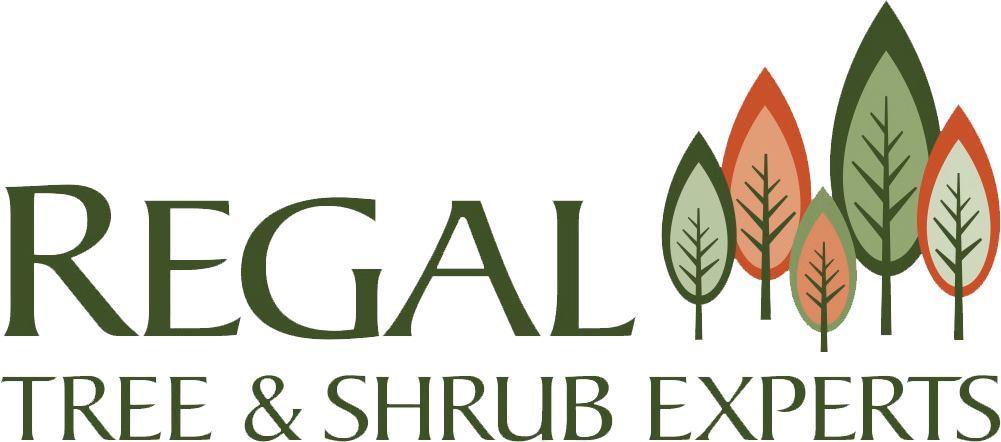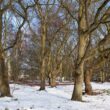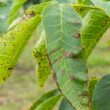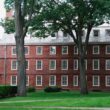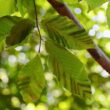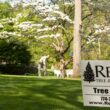If you live in South Easton, Norfolk, or anywhere in Norfolk County, you’ve probably heard neighbors talking about the emerald ash borer. This tiny green beetle has been making its way through Massachusetts for over a decade, and it’s had a real impact on the beautiful ash trees that line our streets and fill our yards. Since EAB was first confirmed in Norfolk County back in 2017 in nearby Brookline and Dedham, it’s become a reality that every homeowner with ash trees needs to understand.
The good news is that we’re not helpless against this invasive pest. There are proven treatment options, ongoing research is showing promising results with biological control, and Certified Arborists like our team know exactly how to help you make the best decisions for your trees and your budget.
Key Takeaways
- First detected in Brookline and Dedham in 2017, the pest is now present throughout our area, including South Easton and surrounding communities.
- Ash trees with less than 30% crown decline can often be successfully treated and saved.
- Parasitoid wasps released since 2013 are establishing populations and beginning to provide natural EAB control.
- Emamectin benzoate injections provide 2-3 years of protection when Certified Arborists apply them.
- ISA Certified Arborists can determine if your ash tree is worth treating or if removal is the safer, more cost-effective option.
- Trees with more than 50% crown decline are generally not good candidates for treatment investment.
EAB’s Journey Through Massachusetts to Norfolk County
The emerald ash borer story in Massachusetts began in 2012 when a single adult beetle was caught in a purple trap in Dalton, a small town in the Berkshires. At the time, many of us in the greater South Easton area thought this invasive pest would stay out west. We were wrong.
EAB moved steadily eastward through the state. According to the Massachusetts Department of Conservation and Recreation, the beetle reached Norfolk County in 2017 when it was detected in Brookline and Dedham. Since then, it has spread to communities throughout our region, including Norwood, Belmont, and other towns that border our service area.
Today, EAB has been confirmed in 280+ communities across 12 Massachusetts counties. The entire state is under a federal quarantine, which means moving ash firewood, nursery stock, or other ash materials is restricted to slow the spread.
Local Insight: “We started seeing the telltale signs of EAB damage in Norfolk County ash trees around 2018-2019,” says Kevin Johnston, owner of Regal Tree & Shrub Experts. “At first, homeowners would call about trees that seemed to be declining for no apparent reason. Now we know those were likely early EAB infestations. The good news is that we’ve learned a lot about how to help homeowners make smart decisions about their ash trees.”
The reality for South Easton, Norfolk, Medfield, and surrounding communities is that EAB is here to stay. But that doesn’t mean we should write off all ash trees. Understanding what you’re dealing with and knowing your options can help you protect valuable trees and make informed decisions about ones that are beyond saving.
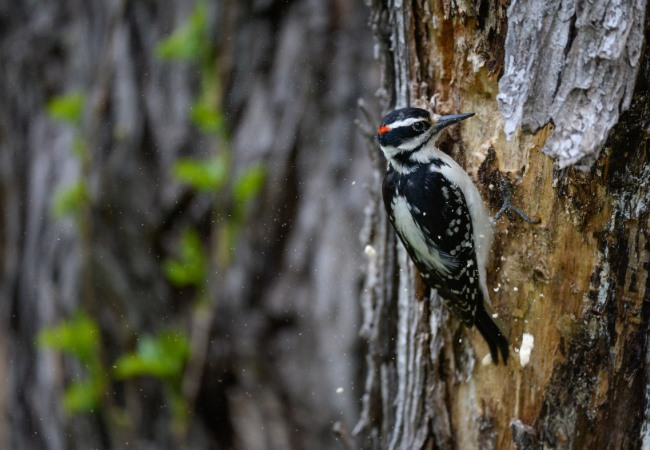
Woodpeckers are natural predators of EAB larvae and their feeding activity often creates the first visible sign of infestation homeowners notice.
Recognizing EAB Damage in South Easton Area Trees
Recognizing EAB damage early can mean the difference between saving a tree and losing it entirely. In our Norfolk County service area, we typically see EAB damage progress as follows:
-
Thinning Upper Canopy: Branches fail to leaf out in spring, or leaves turn yellow and drop prematurely.
-
Top-Down Crown Dieback: Decline usually starts at the top and moves downward.
-
D-shaped exit holes: Tiny (1/8″) holes in the bark where adult beetles have emerged.
-
Serpentine galleries: Winding tunnels under the bark created by EAB larvae.
-
Blonding: Pale patches on bark caused by woodpeckers stripping it away to feed on larvae.
In our experience throughout Norfolk County, ash trees can decline rapidly once EAB becomes established. University of Massachusetts research indicates that small trees may die within 1-2 years of infestation, while larger trees can survive 3-4 years before succumbing.
Another sign to watch for is epicormic sprouting – clusters of small shoots growing directly from the trunk or main branches. This is the tree’s stress response as it tries to produce new foliage to replace what it’s losing to EAB damage. If you’re seeing these symptoms, it’s worth reading our guide on invasive insects attacking Massachusetts trees to understand the broader pest landscape affecting our region.
Massachusetts Leads the Fight with Biocontrol Success Stories
While EAB continues to spread, Massachusetts is at the forefront of promising biological control research that offers hope for long-term ash tree survival. Since 2013, state agencies have been releasing tiny parasitoid wasps that specifically target emerald ash borer in its egg and larval stages.
The program focuses on three species of wasps from EAB’s native range in Asia:
- Tetrastichus planipennisi (which attacks larvae)
- Oobius agrili (which parasitizes eggs)
- Spathius galinae (the newest addition, which has shown exceptional promise).
These wasps don’t sting people or pets – they’re so small you’d need a magnifying glass to see them clearly.
Recent research highlighted by WBUR shows encouraging results from biocontrol efforts in Massachusetts and Connecticut. Scientists are finding established parasitoid populations at release sites, with some species showing particularly impressive performance in attacking EAB larvae.
What makes this research especially relevant for Norfolk County homeowners is that Massachusetts has established biocontrol release sites relatively close to our area. The Department of Conservation and Recreation has identified release locations in North Andover and multiple sites in western Massachusetts. These populations are expected to spread naturally over time.
“The biocontrol wasps are basically doing what nature intended,” explains Dr. Claire Rutledge of the Connecticut Agricultural Experiment Station in the WBUR report. “When regeneration starts to happen, after the EAB levels drop, the parasitoids will be able to keep those populations down so that the new ash can grow and escape.”
The timeline for biocontrol success is measured in decades, not years. While these natural enemies of EAB are establishing and spreading, they won’t provide immediate protection for ash trees currently under attack. That’s where professional treatment comes in.
Research published in Entomology Today shows that Spathius galinae established wild populations within just two years of release and achieved parasitism rates as high as 49% in pole-sized trees. The long-term outlook is genuinely hopeful, though biocontrol success unfolds over decades rather than years.
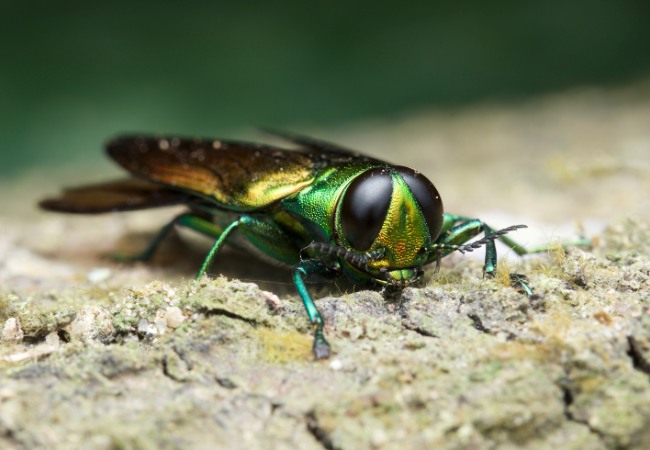
Adult emerald ash borer beetles are small (about 1/2 inch long) with distinctive metallic green coloring and coppery-red abdomen.
Treatment Options for Norfolk County Homeowners
When it comes to protecting ash trees from EAB in South Easton and the surrounding areas, you have several proven treatment options. The key is understanding which approach makes sense for your specific situation and budget.
Professional Emamectin Benzoate Injections for Long-Term Protection
Emamectin benzoate trunk injections are widely considered the most effective EAB treatment available, with USDA Forest Service research showing this treatment can provide 2-3 years of protection with a single application, even in trees with existing EAB damage.
This treatment requires professional application using specialized injection equipment. The arborist drills small holes around the base of the tree and injects the systemic insecticide directly into the sapwood. The chemical moves throughout the tree, killing EAB larvae when they feed.
Arborists time emamectin benzoate applications carefully. Treatments work best when applied between mid-May and mid-June, after trees have leafed out but before EAB eggs hatch. The insecticide needs 2-4 weeks to distribute throughout the tree, so early application is important.
One significant advantage of emamectin benzoate is its ability to serve as a “rescue treatment.” Research shows it can help trees recover even when they’ve sustained up to 30% crown decline from EAB damage. However, studies indicate that trees with more than 50% crown decline generally don’t respond well to treatment. For severely damaged trees, our tree recovery program may offer alternative solutions to help restore tree health.
Homeowner-Applied Imidacloprid Soil Treatments
Imidacloprid is the most widely available EAB treatment and the only one homeowners can purchase and apply themselves. It’s typically applied as a soil drench or granular application around the base of the tree.
The main advantages of imidacloprid are lower cost and easier application. However, it requires annual applications and can take longer to provide full protection – sometimes up to two years for larger trees. University research indicates that imidacloprid works best on smaller trees (less than 6 inches in diameter) and should be applied preventively before EAB infestation becomes severe.
When Treatment Makes Financial Sense
The decision to treat an ash tree should be based on several factors. Consider the tree’s size, health, location, and value to your property. A large, healthy ash tree in a prominent location may be worth treating, while a small or declining tree near a building might be better removed.
For mature trees with good health and valuable locations, treatment typically makes more financial sense than removal and replacement. Professional treatments provide longer-lasting protection than DIY approaches.
Keep in mind that treatment is an ongoing commitment. Even with emamectin benzoate’s longer protection window, you’ll need repeat applications every 2-3 years for the life of the tree. For trees that aren’t good treatment candidates, our tree removal service can safely eliminate hazardous trees and prepare the area for replanting.
Making the Right Decision for Your Ash Trees
The decision to treat or remove an EAB-threatened ash tree isn’t always straightforward. In our experience serving Norfolk County homeowners, several factors should guide your choice:
- Assess Your Tree’s Current Health Honestly: If crown decline exceeds 30-50%, treatment is unlikely to be successful, and removal may be the more prudent option. Trees showing extensive woodpecker activity, multiple years of crown decline, or structural problems are generally poor treatment candidates.
- Consider The Tree’s Location And Value: An ash tree that provides significant shade for your home, serves as a focal point in your landscape, or would be extremely expensive to replace may justify treatment costs. Conversely, ash trees growing too close to buildings, utility lines, or other structures might pose risks that outweigh treatment benefits.
- Think About Your Long-Term Plans: If you’re planning major landscape changes, home renovations, or have concerns about property maintenance commitments, removal might make more sense than entering into a multi-year treatment program.
- Make Your Decision at the Right Time: Preventive treatment is always more effective and cost-efficient than rescue treatment. If you’re on the fence about an ash tree that’s still healthy, it’s better to start treatment before EAB damage becomes obvious. Our plant health care program takes a proactive approach to protecting trees from pests and diseases before problems become severe.
Professional Perspective: “We always tell homeowners that there’s no one-size-fits-all answer,” notes Kevin Johnston. “A tree that makes sense to treat for one family might be better removed for their neighbors. We take the time to evaluate each situation individually and help people make decisions they’ll be happy with long-term.”
Don’t forget to factor in the broader picture. While current EAB treatment requires ongoing investment, the biocontrol programs underway may reduce treatment needs in the future. Some homeowners choose to treat valuable trees now while natural controls establish, with the goal of eventually reducing or eliminating treatment needs.
Frequently Asked Questions
Is EAB still spreading in Norfolk County?
Yes, EAB continues to spread throughout Norfolk County and surrounding areas. While we first confirmed it in our county in 2017, new infestations are still discovered as the beetle spreads naturally and through human transport of infested materials. All ash trees in our area should be considered at risk.
How can I tell if my ash tree has EAB damage?
Look for crown decline starting at the top of the tree, D-shaped exit holes in the bark (about 1/8 inch wide), serpentine galleries under loose bark, and woodpecker “blonding” where birds have stripped bark to feed on larvae. Increased woodpecker activity around ash trees is often the first sign homeowners notice.
Can biocontrol wasps harm other insects or people?
No, the parasitoid wasps used for EAB biocontrol are extremely small (you’d need a magnifying glass to see them clearly) and are host-specific to emerald ash borer. They don’t sting people or pets, and extensive testing confirmed they won’t attack native wood-boring beetles or other beneficial insects.
What happens if I don’t treat my ash tree?
Untreated ash trees in EAB-infested areas typically die within 2-4 years once the beetle becomes established. Small trees may decline faster, while larger trees can sometimes survive longer. However, once significant crown decline begins, the tree becomes a safety hazard and will eventually need removal.
Can I move firewood if it’s from my own ash tree?
You should not transport ash firewood outside your immediate property, even if it’s from your own tree. EAB larvae can survive in cut wood for over a year, and moving firewood is one of the primary ways this pest spreads to new areas. Always burn firewood where you cut it or purchase certified heat-treated firewood.
Will EAB attack other tree species in Massachusetts?
EAB primarily attacks ash species (white ash, green ash, and black ash), but research has confirmed it can also develop in white fringe tree and cultivated olive. However, ash trees remain the primary host, and EAB doesn’t pose a significant threat to other common Massachusetts tree species like oak, maple, or pine.
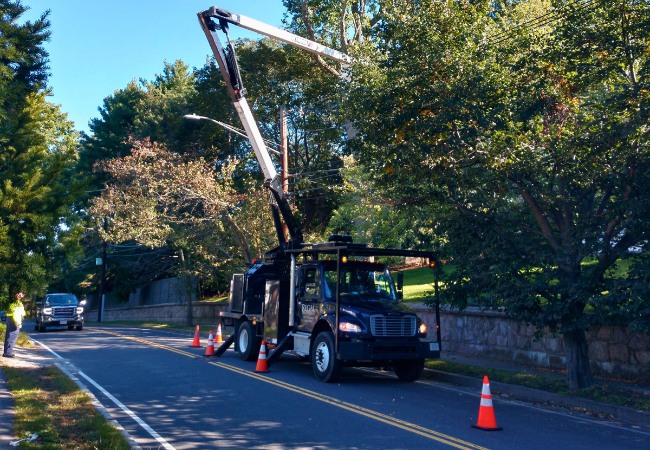
Professional tree service equipment like cranes and bucket trucks allows Certified Arborists to safely remove EAB-damaged ash trees and perform treatments in residential areas.
Moving Forward with Confidence
The emerald ash borer challenge in South Easton and Norfolk County is real, but it’s not insurmountable. With proper assessment, timely treatment, and realistic expectations, many valuable ash trees can be protected while biocontrol programs work toward long-term solutions.
The key is working with professionals who understand both the science of EAB management and the practical realities of homeowner decision-making. At Regal Tree & Shrub Experts, our ISA Certified Arborists have the training and experience to help you evaluate your ash trees, understand your options, and make decisions that align with your goals and budget.
Whether you’re dealing with a prized ash tree that anchors your landscape or trying to decide if treatment makes sense for multiple trees on your property, we’re here to provide honest, expert guidance. Call Regal Tree & Shrub Experts at 774-719-2450 or request a free estimate to have one of our certified arborists assess your ash trees and discuss your options.
